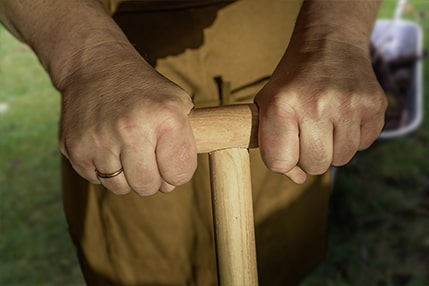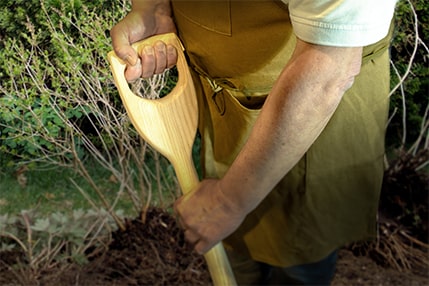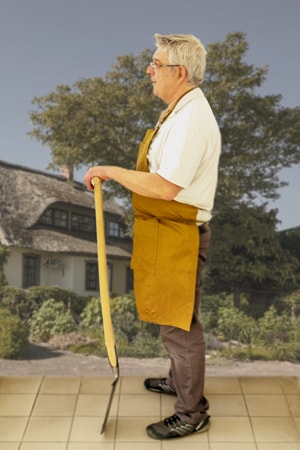Effortless gardening
When gardening, spades and shovels are the tools that guarantee sweaty work. To avoid inflicting back pain on yourself in addition to this, make sure that the spade or shovel suits the work requirements and, above all, is ergonomically suited to you.
T-Handle
The T-handle makes work easier when you really need to dig deep. For example, when cutting lawn edges, when digging up heavy soil or when you want to make use of the leverage effect. A T-handle is also the more comfortable option when digging over beds. T-shaped spade handles are often slightly curved and equipped with a forward-angled spade blade. This makes it easier to transport loosened soil on the levelled shovel blade after trenching or loosening.

D-Handle
For tasks where precision is more important than force, a spade with a D-handle is usually the better choice. This handle shape is particularly popular when trimming root balls or digging holes. The fingers do not have to be spread to grip the handle centrally. D-shaped spade handles are often straight and feature a spade blade positioned at only a slight angle.

Knob Handle
Finally, there is the knobbed handle, which, apart from the slightly lower weight, is mainly conspicuous for its poorer ergonomics and even worse transmission of force. If you only have light work to do, the knob handle is certainly a possible alternative.
In our range you will find both spades with T-handles and spades with D-handles.
By the way, with a good spade, a little practice and easy-to-work soil, you can dig up to 30 square metres per hour - no matter which wooden handle you prefer.
Handle Length
The length of the handle should definitely be appropriate for your height. If the handle is too short, you run the risk of hunching your back too much all the time. This overstresses muscles, tendons and your spine, resulting in back pain. Check if your spade has the right handle length by standing it on the ground in front of you. If your hand can comfortably reach the handle with your forearm extended at right angles to your body, the handle length is optimum for your body height.

FAQs on Shovels and Spades
What is the difference between a shovel and a spade?
A spade is a special form of shovel. Shovels are used to easily pick up and carry away loose material. Spades, on the other hand, are primarily used for loosening or digging up soil.
What makes a good spade?
A spade should be selected appropriately for the intended use. The heavier or loamier the soil, the smaller the spade blade should be. In order to protect your shoes when driving the spade into the ground, the edge tread should be widened, for example by means of tread sleeves such as those on the Baack Eiderstedter Spade.
How do I prepare spades and shovels for storage over the winter?
Clean the coarse dirt from your spade or shovels. If necessary, use a wire brush. In the next step, remove the rust film, for example with a flap sander. Then wash your equipment with a light soapy water solution. After drying, rub the shovel and spade thoroughly with oil and store them in a dry place until next year.
How do I sharpen spades?
If the blade on a spade becomes thinner downwards this is called a »self-sharpening« spade. The idea is that by using a spade in hard, stony ground the thin blade will »sharpen« itself as its rubs against the stones. Essentially, the sharpening is left to chance.
Spades are usually sharpened with an inside bevel of 25°–35° depending on the ground conditions. We recommend using a half-round file for sharpening.


